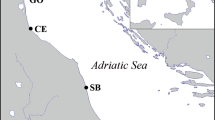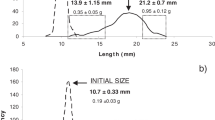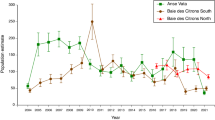Abstract
THOMAS et al.1,2 have questioned the ability of molluscs to limit their population size by self inhibition at high densities. They suggest that plant metabolites may have caused the reduction in growth and fecundity of the aquatic snail Biomphalaria glabrata Say ascribed to crowding in previous studies3,4. Field evidence for density-dependent regulation is limited. Yom-Tov5 found that the fecundity of the desert snail Trochoidea seetzeni Pfeiffer was adversely affected by population density; he considered that either self-inhibition or nutritional differences were responsible. While studying the population dynamics and energetics of the land snail Cepaea nemoralis L., we have found evidence for density-dependent effects that cannot readily be explained by resource limitation. In samples of C. nemoralis collected in 1968 to study shell polymorphism (M. A. Palles-Clark, unpublished) a negative correlation was noticed between adult shell diameter and sample size (r =−0.60, P <0.001). Snails were collected from chalk grassland between Beacon Hill and Round Down, West Sussex. A more detailed study carried out in the same area during the summer of 1973 confirmed this effect. The density of adult C. nemoralis was measured by mark-recapture at nine 20 × 20 m sites, situated 100–600 m apart. Each site was sampled in May, June and August. As there were insufficient recaptures to use multiple recapture methods for all sites, adult population densities were estimated for the second sampling occasion using the Lincoln index.
This is a preview of subscription content, access via your institution
Access options
Subscribe to this journal
Receive 51 print issues and online access
$199.00 per year
only $3.90 per issue
Buy this article
- Purchase on Springer Link
- Instant access to full article PDF
Prices may be subject to local taxes which are calculated during checkout
Similar content being viewed by others
References
Thomas, J. D., in Advances in Parasitology, 11 (edit. by Dawes, B.), 307–394 (Academic, London, 1973).
Thomas, J. D., Goldsworthy, G. J., and Aram, R. H., J. anim. Ecol., 44, 1–27 (1975).
Berrie, A. D., and Visser, S. A., Physiol. Zool, 36, 167–173 (1963).
Levy, M. G., Tunis, M., and Isseroff, H., Nature, 241, 65–66 (1973).
Yom-Tov, Y., J. anim. Ecol., 41, 17–22 (1972).
Williamson, P., J. anim. Ecol. (in the press).
Wolda, H., Arch. Neerl. Zool., 15, 381–471 (1963); Evolution, 21, 117–129 (1967).
Cook, L. M., and O'Donald, P., in Ecological Genetics and Evolution (edit. by Creed, R.), 93–108 (Blackwell, Oxford, 1971).
Wolda, H., J. anim. Ecol., 38, 305–327 (1969).
Williamson, P., thesis, Portsmouth Polytechnic (1975).
Wolda, H., Israel J. Malacol., 3, 63–71 (1972).
Author information
Authors and Affiliations
Rights and permissions
About this article
Cite this article
WILLIAMSON, P., CAMERON, R. & CARTER, M. Population density affecting adult shell size of snail Cepaea nemoralis L.. Nature 263, 496–497 (1976). https://doi.org/10.1038/263496b0
Received:
Accepted:
Issue Date:
DOI: https://doi.org/10.1038/263496b0
This article is cited by
-
Intra-specific morphological variation of the spermatheca in the simultaneously hermaphroditic land snail Helix aperta
Zoomorphology (2018)
-
Host-dependent variation in density of corallivorous snails (Coralliophila spp.) at Curaçao, southern Caribbean
Marine Biodiversity (2017)
-
Coexistence of the endangered, endemic Chittenango ovate amber snail (Novisuccinea chittenangoensis) and a non-native competitor
Biological Invasions (2015)
-
Interspecific interference competition alters habitat use patterns in two species of land snails
Evolutionary Ecology (2010)
-
Weather- and population density-induced infantilism in the landsnailTheba pisana in a semi-arid climate
International Journal of Biometeorology (1989)
Comments
By submitting a comment you agree to abide by our Terms and Community Guidelines. If you find something abusive or that does not comply with our terms or guidelines please flag it as inappropriate.



